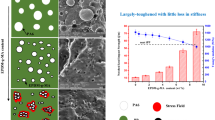Abstract
Cenosphere-filled polypropylene (PP) composites were fabricated and characterized for their structural/morphological and fracture mechanical behaviour. The fracture properties were studied following the essential work of fracture (EWF) approach based on post-yield fracture mechanics (PYFM) concept. The structural attributes and its consequent effects on the dynamic mechanical properties were characterized by wide angle X-ray diffraction (WAXD), hot-stage polarized light optical microscopy (PLOM) and dynamic mechanical analysis (DMA). The WAXD studies have revealed a decrease in crystallinity of the composites with increase in cenosphere content. PLOM studies reveals a threefold reduction in the diameter of the spherulite in case of composite with 10 wt% of cenosphere compared to that of PP followed by an increase of ~50% in the composite with 20 wt% of cenosphere compared to that of the composite with 10 wt% cenosphere. DMA revealed an enhancement in the energy dissipation ability of the composite with 10 wt% of cenosphere and an increase in the storage modulus up to ~30% in the composites relative to the soft PP phase. The non-essential work of fracture (NEWF: βw p) as the resistance to stable crack propagation has shown a maximum at 10 wt% of cenosphere followed by a sharp drop at higher cenosphere content indicating a cenosphere-induced ductile-to-brittle transition (DBT). Fractured surface morphology investigations revealed that the failure mode of the composites undergo a systematic transition from matrix-controlled shear deformation to filler-controlled quasi-brittle modes above a cenosphere loading of 10 wt% in the composites reiterating the possibility of filler-induced semiductile-to-DBT transition.









Similar content being viewed by others
References
Fröhlich J, Niedermeier W, Luginsland HD (2005) Compos Part A Appl Sci Manuf 36(4):449
Bartczak Z, Argon AS, Cohen RE, Weinberg M (1999) Polymer 40(9):2347
Kolay PK, Singh DN (2001) Cement Concrete Res 31(4):539
Cardoso RJ, Shukla A, Bose A (2002) J Mater Sci 37:603. doi:10.1023/A:1013781927227
Debnath DC, Bandyopadhyaya S, Yu A, Zeng Q, Das T, Blackburn D, White C (2009) J Mater Sci 44:6078. doi:10.1007/s10853-009-3839-3
Devi MS, Murugesan V, Rengaraj K, Anand P (1998) J Appl Polym Sci 69:1385
Sole BM, Ball A (1996) Tribol Int 29:457
Suresha B, Chandramohan G, Siddaramaiah, Jayaraju T (2008) Polym Compos 29(3):307
Ramachandra M, Radhakrishna K (2007) Wear 262(11–12):1450
Nandan D, Tomar BS, Satapathy BK (2009) Mater Des 30(10):4369
Gu J, Wu G, Zhao X (2009) Polym Compos 30(2):232
Gu J, Wu G, Zhao X (2008) J Univ Sci Technol Beijing 15:509
Gu J, Wu G, Zhang Q (2007) Mater Sci Eng A 452–453:614
Jarvela PA, Jarvela PK (1996) J Mater Sci 31:3853. doi:10.1007/BF00352802
Murugendrappa MV, Khasim S, Prasad MVNA (2005) Bull Mater Sci 28:565
Rohatgi PK, Matsunga T, Gupta N (2009) J Mater Sci 44:1485. doi:10.1007/s10853-008-3165-1
Deepthi MV, Sharma M, Sailaja RRN, Anantha P, Sampathkumaran P, Seetharamu M (2010) Mater Des 31:2051
Wong KWY, Truss RW (1994) Compos Sci Technol 54:361
Tagliavic G, Porfiri M, Gupta N (2010) Compos Part: B Eng 41:86
Hashemi S (2003) J Mater Sci 38:3055. doi:10.1023/A:1024752508458
Orange E, Bomal Y (2003) Eur Struct Integr Soc 32:39
Liang JZ, Li RKY (1999) Polymer 40:3191
Orange G (2000) Eur Struct Integr Soc 27:247
Gong G, Xie BH, Yang W, Li ZM, Zhang WQ, Yang MB (2005) Polym Testing 24:410
Lach R, Schneider K, Weidisch R, Janke A, Knoll K (2005) Eur Polym J 41(2):383
Mai YW, Powell P (1991) J Polym Sci Part B Polym Phys 29:785
Hill RH (1952) J Mech Phys Solids 1:19
Mai YW, Cotterell B (1986) Int J Fracture 32:105
Das A, Satapathy BK (2010) Mater Des. doi:10.1016/j.matdes.2010.08.041
Wang K, Wu J, Zeng H (2003) Eur Polym J 39:1647
Nitta K, Asuka K, Liu B, Terano M (2006) Polymer 47:6457
Imai M, Kaji K (2006) Polymer 47:5544
Ganß M, Satapathy BK, Thunga M, Weidisch R, Pötschke P, Jehnichen D (2008) Acta Mater 56(10):2247
Chen YH, Mai YW, Tong P, Zhang LC (2000) In: Williams JW, Pavan A (eds) Fracture of polymers, composites and adhesion. ESIS Publication, 27. Elsevier, Amsterdam, p 175
Arkhireyeva A, Hashemi S, O’Brien M (1999) J Mater Sci 34:5961. doi:10.1023/A:1004776627389
Hashemi S, Williams JG (2000) Plast Rubber Compos 29:294
Satapathy BK, Weidisch R, Poetschke P, Janke A (2005) Macromol Rapid Commun 26:1246
Grellmann W, Caesar T, Heinrich G (1999) Kauts Gummi Kunst 52:37
Grellmann W, Heinrich G, Caesar T (2001) In: Grellmann W, Seidler S (eds) Deformation and fracture of polymers. Springer, Berlin, Heidelberg, p 479
Reincke K, Lach R, Grellmann W, Heinrich G (2001) In: Grellmann W, Seidler S (eds) Deformation and fracture of polymers. Springer, Berlin, Heidelberg, p 493
Lach R, Antonova GL, Grellmann W (2007) Polym Testing 26(1):51
Zeng XF, Wang WY, Wang GQ, Chen JF (2008) J Mater Sci 43:3505. doi:10.1007/s10853-008-2475-7
Seelig T (2004) On micromechanical modeling of toughening mechanisms and failure in amorphous thermoplastic polymer blends. Vom Fachbereich Mechanik der Technischen Universitat Darmstadt genehmigte Habilitationsschrift
Haworth B, Raymond CL, Sutherland I (2001) Polym Eng Sci 41:1345
Kinloch AJ, Young RJ (1983) Applied science. London
Acknowledgements
The authors gratefully acknowledge the help extended by Mr. Ratnesh Jain of Micro Minechem India Pvt. Ltd. in providing the flyash-based cenospheres used in this study.
Author information
Authors and Affiliations
Corresponding author
Rights and permissions
About this article
Cite this article
Satapathy, B.K., Das, A. & Patnaik, A. Ductile-to-brittle transition in cenosphere-filled polypropylene composites. J Mater Sci 46, 1963–1974 (2011). https://doi.org/10.1007/s10853-010-5032-0
Received:
Accepted:
Published:
Issue Date:
DOI: https://doi.org/10.1007/s10853-010-5032-0




